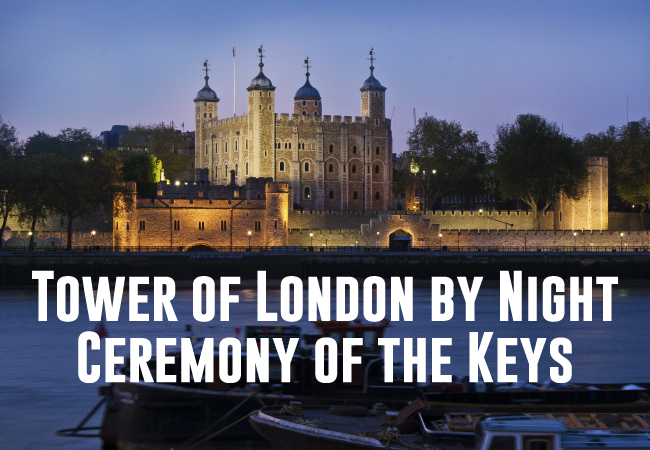His Majesty’s Royal Palace and Fortress, otherwise known as the Tower of London, is a historic castle on the north bank of the River Thames. Built by William the Conqueror in 1078, it was a resented symbol of oppression, inflicted upon London by the new ruling elite.
Today the Tower of London is one of the world’s major tourist attractions and a World Heritage Site, attracting over two million visitors a year from all over the world.
What is the Ceremony of the Keys?
The ancient custom of the Ceremony of the Keys is the formal locking of the Tower of London’s gates. It occurs every night, without fail, since 1340.
At exactly 9.53pm, the Chief Yeoman Warder emerges from the Byward Tower wearing his long red coat and Tudor bonnet. He carries in one hand a candle lantern and in the other hand the King’s Keys. He meets the military escort, made up of members of the Tower Guard and together they secure the main gates.
Following this, the party makes its way through the Bloody Tower Archway into the fortress, where they halt at the bottom of the Broadwalk Steps. On the top of the Stairs, under the command of their officer, the Tower Guard present arms and the Chief Warder raises his hat to salute the King. He then takes the keys to the King’s House for safekeeping, while the drummer sounds The Last Post.
It’s important to secure the fortress for the night because, although the Monarch no longer resides at this royal palace, the Crown Jewels and many other valuables still do.
What else is there to see at the Tower of London?
Before closing, visit the Tudor chapel containing monuments to residents of the Tower and its prisoners, including those executed on Tower Green. Originally a parish church, the chapel was incorporated into the walls of the castle during Henry III’s expansion. Buried inside are three queens of England, Anne Boleyn, Catherine Howard and Jane Grey, and two saints of the Roman Catholic Church, Sir Thomas More and John Fischer. Their headless bodies were buried under the nave or chancel without memorial until the 19th century. Once found, they were re-interred in the crypt. The chapel also has many monuments which commemorate officers and residents of the Tower who worshipped here. It remains a place of worship for the Tower’s community of 150 or so residents.
Did You Know?
The Tower itself is the most haunted building in England. The most tragic of English monarchs, Henry VI, haunts its Wakefield Tower. His weak and ineffectual reign ended here “in the hour before midnight” on 21st May 1471. He was murdered as he knelt at prayer.
Want to explore more?
Why not hop on the London by Night Bus Tour to see the city’s iconic landmarks illuminated in the twilight.
Don’t forget to tag us in your adventures @goldentoursuk!

